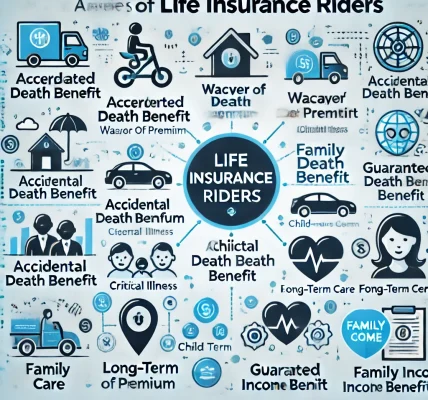Introduction
If you have a pre-existing health condition, you may wonder if you can qualify for life insurance. Many people believe that having a medical history of conditions like diabetes, heart disease, or high blood pressure automatically disqualifies them from coverage. However, that’s not entirely true.
In this guide, we’ll break down how individuals with pre-existing conditions can still secure affordable life insurance, what factors influence approval, and how to improve your chances of getting the best policy.
1. What Are Pre-Existing Health Conditions?
A pre-existing condition refers to any health issue diagnosed before applying for life insurance. Insurers evaluate these conditions based on severity, treatment, and impact on life expectancy. Common pre-existing conditions include:
✅ Diabetes (Type 1 and Type 2) ✅ High blood pressure (Hypertension) ✅ Heart disease ✅ Asthma and other respiratory issues ✅ Cancer (in remission or undergoing treatment) ✅ Obesity ✅ Depression and anxiety ✅ Kidney disease ✅ HIV/AIDS (limited insurers offer coverage)
The impact of these conditions varies—some may lead to higher premiums, while others may result in policy exclusions or denial.
2. Can You Get Life Insurance with a Pre-Existing Condition?
Yes! While it may be more challenging, many insurance companies offer policies designed for individuals with health issues. Your approval depends on factors such as:
🔹 Severity of Your Condition
- Mild conditions (e.g., controlled hypertension) may not affect premiums significantly.
- More severe cases (e.g., a recent heart attack) might require higher premiums or waiting periods.
🔹 Current Treatment & Management
- Insurers favor applicants who actively manage their health.
- Regular doctor visits, medications, and lifestyle improvements can improve your approval chances.
🔹 Time Since Diagnosis
- If your condition is recently diagnosed, insurers may require a waiting period.
- Conditions in remission or well-managed for years often get better rates.
🔹 Medical Examinations
- Some insurers require medical exams, while others offer no-medical-exam policies for higher premiums.
3. Types of Life Insurance Available for People with Pre-Existing Conditions
Several life insurance options are available, even if you have a medical history:
🔸 Term Life Insurance
✅ Affordable and provides coverage for 10, 20, or 30 years. ✅ Best for mild to moderate pre-existing conditions. ✅ Requires a medical exam in most cases. ✅ Lower premiums compared to whole life insurance.
🔸 Whole Life Insurance
✅ Offers lifetime coverage with a guaranteed death benefit. ✅ Higher premiums but builds cash value over time. ✅ Best for individuals with moderate to severe conditions who want lifelong protection.
🔸 Guaranteed Issue Life Insurance (No-Medical Exam)
✅ No medical exam required—approval is guaranteed. ✅ Limited coverage amounts ($25,000–$50,000 typically). ✅ Best for individuals with serious or terminal conditions. ✅ Higher premiums due to higher risk for insurers.
🔸 Simplified Issue Life Insurance
✅ No medical exam but requires a health questionnaire. ✅ Faster approval process than traditional life insurance. ✅ Suitable for moderate health conditions.
🔸 Group Life Insurance
✅ Often available through employers with no medical exams. ✅ Premiums may be lower but coverage is limited. ✅ Best for individuals with severe conditions who may not qualify for personal policies.
Each type has pros and cons, so choosing the right one depends on your health status and financial goals.
4. How to Improve Your Chances of Getting Approved
If you have a pre-existing condition, here are ways to increase your chances of getting life insurance approval:
✅ Manage Your Condition: Regular check-ups and following treatment plans show insurers that you are in stable health. ✅ Maintain a Healthy Lifestyle: Exercise, a balanced diet, and avoiding smoking/alcohol lower risks. ✅ Choose the Right Insurer: Some insurers specialize in high-risk applicants—compare multiple quotes. ✅ Consider a No-Exam Policy: If traditional insurers decline, look for simplified issue or guaranteed issue plans. ✅ Apply at the Right Time: If recently diagnosed, waiting a year while managing your condition may improve approval chances. ✅ Be Honest in Your Application: Never hide medical history—insurers verify records, and dishonesty can lead to policy denial.
5. How Much Will Life Insurance Cost with a Pre-Existing Condition?
Premiums depend on several factors:
💰 Type & Severity of Condition: More severe conditions = higher premiums. 💰 Age: Younger applicants get lower rates. 💰 Coverage Amount: Higher coverage = higher costs. 💰 Medical Exam Results: Better health metrics reduce premiums. 💰 Policy Type: Term insurance is cheaper than whole life.
🔹 Example Premiums:
| Condition | Policy Type | Estimated Monthly Cost |
|---|---|---|
| Controlled Hypertension | Term (20 years, $500K) | $30–$50 |
| Type 2 Diabetes | Whole Life ($250K) | $80–$150 |
| Cancer Survivor (5 years remission) | Simplified Issue ($100K) | $100–$200 |
Note: Rates vary—getting a personalized quote is essential.
6. Common Mistakes to Avoid When Applying
🚫 Not Shopping Around: Every insurer evaluates risk differently—compare multiple options. 🚫 Delaying the Application: The longer you wait, the higher the premiums. 🚫 Choosing the Wrong Policy Type: Term insurance is cheaper but may not suit long-term needs. 🚫 Hiding Medical History: Insurers will verify your health records—be transparent. 🚫 Ignoring Employer Group Plans: Workplace life insurance may be easier to obtain.
Conclusion
Having a pre-existing health condition doesn’t mean you can’t get life insurance. While coverage may come with higher premiums or policy restrictions, there are still many options available.




